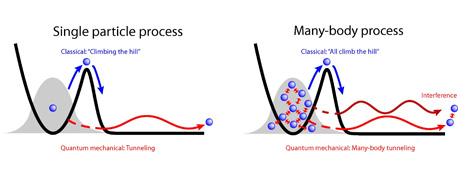Mechanism of many-body tunneling process first described exactly
12 October 2012

With research concerning the tunneling effect, one of the central effects in quantum mechanics, Heidelberg scientists were the first to give an exact description ofthe many-body tunneling process to open space exactly for the first time. At the same, time the scientists supervised by Prof. Dr. Lorenz Cederbaum were able to show the fundamental differences to the well-known tunneling process of single particles. The results of this study, made in cooperation with an Israeli scientist, have been published in the “Proceedings of the National Academy of the Sciences” (PNAS).
Due to the tunneling effect, quantum mechanically described particles are able to overcome potential barriers without having sufficient energy to do so – they hence “tunnel” through the barrier. In contrast, for particles described by classical mechanics only a “climbing over the barrier” is allowed. The tunneling effect occurs in various different processes in nature. These are, for instance, nuclear fusion, nuclear fission, and alpha decay in nuclear physics as well as ionisation processes, photoassociation and photodissociation in biology and chemistry. These processes almost exclusively take place in systems that are open and consist of many particles interacting with each other. Axel Lode, Dr. Alexej Streltsov and Dr. Kaspar Sakmann under the supervision of Prof. Cederbaum of the Heidelberg University’s Institute for Physical Chemistry have now investigated how the mechanism of tunneling processes to open space works. The cooperation partner of the Heidelberg scientists was Prof. Ofir Alon of Haifa University.
The tunneling process of single particles has been well-understood in quantum mechanics since decades – yet almost nothing is known on the tunneling process of many particles interacting with each other. The question to which extent the interactions between the particles cause the occurrence of cooperative phenomena is of particular interest here. The scientists supervised by Lorenz Cederbaum hence investigated how the tunneling process through a potential barrier into free space of many, interacting, ultracold bosons, which initially form a Bose-Einstein condensate, elapses. Ultracold bosons are well-suited to studying many-body processes because, besides their external potential by lasers, their interactions can be controlled experimentally by magnetic fields.
One of the leading questions of the research was to find out whether the overall many-body tunneling process can be described as the tunneling of a single, effective particle or if this process takes place in a fundamentally different way. The scientists found with the aid of exact numerical simulations that collective phenomena show up in the many-body process even for weak interactions. The phenomenon is a quantum interference – a special phenomenon in quantum mechanics – of single-particle tunneling processes which take place simultaneously and emerge from sources of different numbers of particles. This manifests itself in a growth of correlations, i.e., inter-relations between the initially uncorrelated particles. At the same time, the scientists have shown that the many-body tunneling process cannot be described as the tunneling process of a single effective particle. Such a description as an effective single-particle process neglects the occurrence of the collective phenomena and the build-up of correlations.
Information and further videos can be found online at http://MCTDHB.org and http://tc.uni-hd.de/axel
Original publication:
A. U. J. Lode, A. I. Streltsov, K. Sakmann, O. E. Alon, and L. S. Cederbaum: How an interacting many-body system tunnels through a potential barrier to open space, PNAS 2012 109 (34) 13521-13525, doi:10.1073/pnas.1201345109
Contact:
Prof. Dr. Lorenz Cederbaum
Physikalisch-Chemisches Institut
Phone: +49 6221 54-5211
lorenz.cederbaum@pci.uni-heidelberg.de
Communications and Marketing
Press Office
Phone: +49 6221 542311
presse@rektorat.uni-heidelberg.de
Movie of the tunneling process to open space. Upper panel: The density in blue color. Lower panel: The density of the natural orbitals (multiple colors).
Movie of the loss of coherence in the tunneling process to open space. The momentum density (upper panel) and coherence measured by the first-order correlation function of the particles (lower panel) are shown.

